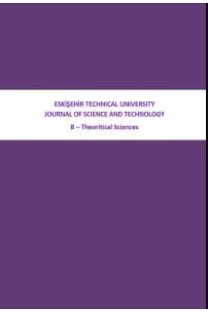BAZI ÇAY BİLEŞENLERİNİN SU VE KAN FAZINDA TEORİK OLARAK İNCELENMESİ
Bu çalışmada, çay bileşiklerinin asitlik sabiti, kararlılık, reaktivite, geometri ve enerji gibi bazı teorik özellikleri, laboratuvar çalışmalarından önce insan vücudundaki davranışlarının temel prensiplerini anlamak için, MOPAC 2009 (PM6 metodu) ile hesaplanmıştır. Çalışılan bileşiklerin proton verme sıraları, dipol momentleri ve nükleofillikleri su ve kan fazında araştırılmıştır. Moleküllerin kararlılık sıralamaları Gibbs serbest enerjileri dikkate alınarak belirlenmiştir. Daha fazla –OH grubu içeren molekülün daha kararlı ve daha az reaktif olduğu gözlenmiştir. Bütün moleküller, su fazında kan fazına göre daha kararlıdır. Hesaplanan asitlik sabitleri deneysel sabitleriyle karşılaştırılmıştır. 1c, 2ec, 3cg, 4ecg; 5egc, 6egcg ve 7ga moleküllerinin su ve kan fazındaki termodinamik pKa değerleri arasında anlamlı bir korelasyon (R2> 0.9999) gözlenmiştir
Anahtar Kelimeler:
Kateşinler, Polifenol, Çay, Teorik hesaplama, PM6, Marvinbeans, Sparc
THEORETICAL INVESTIGATION OF CERTAIN TEA COMPOUNDS IN AQUEOUS AND BLOOD PHASES
In this study, certain theoretical properties of tea compounds, such as acidity constant, stability, reactivity, geometry and energy have been calculated prior to laboratory studies to understand the basic principles concerning their behaviors within the human body by MOPAC2009 with the PM6 method. The order of proton dissociation, dipole moment and nucleophilicity for the studied molecules in aqueous and blood phases were investigated. The order of stabilities of the molecules was determined in relation to the Gibbs free energy. It is observed that any molecule having more of the -OH group has more stability and is less reactive. The stabilities of all the molecules are higher in the aqueous phase than those in the blood phase. Their calculated acidity constants were compared with those of experimental values. Positive meaningful correlations (R2> 0.9999) were observed between thermokinetic pKa values for 1c, 2ec, 3cg, 4ecg, 5egc, 6egcg and 7ga in both aqueous and blood phases.
Keywords:
Catechins, Polyphenol, Tea, Theoretical calculation, PM6, Marvinbeans, Sparc,
___
- AnaMarı´a,M.W.andDaniel,G.M.(2006).Theoreticalstudyofthemolecularproperties and chemical reactivity of (+)-catechin and -)-epicatechin related to their antioxidant ability. Journal of Mo- lecular Structure (Theochem) 761, 97-106.
- Anh,Y.J.,Kawamura,T.,Kim,M.,Yamamoto,T. and Mitsuoka, D. (1991). Tea Polyphenols: Selective Growth Inhibitors of Clostridium spp. Agricultural and Biological Chemistry 55, 14251426.
- Adams, M.L., O’Sullivan, B., Downard, A. and Powell, K.J. (2002). Stability Constants for Aluminum(III)Complexes with the 1,2-Dihydroxyaryl Ligands Caffeic Acid, Chlorogenic Acid, DHB, and DASA in Aqueous Solution. Journal of Chemical Engineering Data 47, 289-296.
- Hatano, T., Yoshida, T. and Hemingway, R.W. (1999). In: Gross, et al. (eds.) Plant Polyphenols 2: Chemistry, Biology, Pharmacology, Ecology; Kluwer, New York.
- Herrero-Martínez, J.M., Sanmartin, M., Rosés, M., Bosch, E. and Ràfols, C. (2005). Determination of dissociation constants of flavonoids by capillary electrophoresis. Electrophoresis 26, 1886- 1895.
- Inoue, M.B., Inoue, M., Fernando, Q., Valcic, S. and Timmermann, B.N. (2002). Potentiometric and 1H NMR studies of complexation of Al3+ with (-)-epigallocatechin gallate, a major active constituent of green tea. Journal of Inorganic Biochemistry 88, 7-13.
- Jankun, J., Selman, S.H., Swiercz, R. and Skrzypczak-Jankun, E. (1997). Why drinking green tea could prevent cancer. Nature 387, 561.
- Ji, H.F., Zhang, H.Y. Shen, L. (2006). Proton dissociation is important to understanding structure– activity relationships of gallic acid antioxidants. Bioorganic & Medicinal Chemistry Letters 16, 4095-4098.
- Kondo, K., Kurihara, M., Miyata, N., Suzuki, T. and Toyoda, M. (1999). Mechanistic Studies of Catechins as Antioxidants against Radical Oxidation. Archives of Biochemistry and Biophysics 362, 79-86.
- Kris-Etherton, P.M. and Keen, C.L. (2002). Evidence that the antioxidant flavonoids in tea and cocoa are beneficial for cardiovascular health. Current Opinion in Lipidology 13, 41-49.
- Nakahara, K., Kawabata, S., Ono, H., Ogura, K., Tanaka, T., Ooshima, T. and Hamada, S. (1993). Inhibitory effect of Oolong tea polyphenols on glucosyltransferases in Mutans streptococci. Applied and Environmental Microbiology 59, 968-973.
- Shahidi, F., Janitha, P.K. and Wanasundara, P.D. (1992). Phenolic antioxidants. Critical Reviews in Food Science and Nutrition 32, 67-103.
- Tam, K.Y. and Takács-Novák, K. (2001). Multi-wavelength spectrophotometric determination of acid dissociation constants: a validation study. Analytica Chimica Acta 434, 157-167.
- Uysal, U.D., Aturki, Z., Raggi, M.A. and Fanali, S. (2009). Separation of catechins and methylxanthines in tea samples by capillary electrochromatography. Journal of Separation Sci- ence 32, 1002-1010.
- Wang, H., Provan, G.J. and Helliwell, K. (2000). Tea flavonoids: their functions, utilization and analysis. Trends in Food Science & Technology 11, 152-160.
- Yang, B., Kotani, A., Arai, K. and Kusu, F. (2001). Relationship of electrochemical oxidation of catechins on their antioxidant activity in microsomal lipid peroxidation. Chemical and Pharmaceutical Bulletin 49, 747-751.
- Yang, C.S., Chen, L., Lee, M.J., Balentine, D., Kuo, M.C. and Schantz, S.P. (1998). Blood and urine levels of tea catechins after ingestion of different amounts of green tea by human volunteers. Cancer Epidemiology, Biomarkers & Prevention 7, 351-354.
- Yang, C.S., Chung, J.Y., Yang, G.Y., Chhabra, S.K. and Lee, M.J. (2000). Tea and tea polyphenols in cancer prevention. Journal of Nutrition 130, 472S-478S.
- Zaveri, N.T. (2006). Green tea and its polyphenolic catechins: Medicinal uses in cancer and noncancer applications. Life Sciences 78(18), 2073-2080.
- Zeeb, D.J., Nelson, B.C., Albert, K. and Dalluge, J. (2000). Seaparation and identification of twelve catechins in tea using liquid chromatography/atmospheric pressure chemical ionization-mass spectrometry. Journal of Analytical Chemistry, 72 (20), 5020-5026.
- http://openmopac.net/MOPAC2009.html/
- https://www.chemaxon.com.
- http://sparc.chem.uga.edu/sparc/
- ISSN: 2667-419X
- Yayın Aralığı: Yılda 2 Sayı
- Başlangıç: 2010
- Yayıncı: Eskişehir Teknik Üniversitesi
Sayıdaki Diğer Makaleler
KAHLER-NORDEN MANİFOLDLARI ÜZERİNDE CLIFFORD DEMETLERİ
REGRESYON ANALİZİNDE DIŞLANAN DEĞİŞKEN YANLILIĞI VE YANLILIĞIN RESET TESTİ İLE TESPİTİ
Suay EREEŞ, Suay EREES, Neslihan DEMİREL
BAZI ÇAY BİLEŞENLERİNİN SU VE KAN FAZINDA TEORİK OLARAK İNCELENMESİ
Ülkü Dilek UYSAL, Halil BERBER, Elif Mine ÖNCÜ KAYA
TÜRKİYE İL-İLÇE MERKEZLERİNDEKİ ÖLÜM ORANLARININ TREND VE LEE-CARTER YÖNTEMLERİ İLE TAHMİNİ
CPG(2,25,5) NIN (k,3)-YAYLARI ÜZERİNE
BLOKLANMIŞ İKİ DÜZEYLİ KESİRLİ ÇOK ETKENLİ TASARIMLARDA BLOK YAPILARININ KARŞILAŞTIRILMASI
